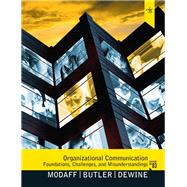
Note: Supplemental materials are not guaranteed with Rental or Used book purchases.
Purchase Benefits
PREFACE
ACKNOWLEDGMENTS
PART ONE: FOUNDATIONS
CHAPTER ONE: INTRODUCTION
Defining the Study and Practice of Organizational Communication
The Changing Landscape of Organizations
Communication Technology and the Organization
The Realities of a Diverse Workforce
Ethical Frameworks and Organizational Communication
The Communicative Organization Model
Anticipate Misunderstandings
Misunderstandings and Conflict
Social Interaction
Strategic Communication Planning
Summary
CHAPTER TWO: CLASSICAL THEORIES OF ORGANIZATIONS
The Metaphor of the Machine
Minimizing Misunderstandings
Taylor’s Theory of Scientific Management
Elements of Scientific Management
Scientific Management in the Modern Workplace
Fayol’s Administrative Theory
Principles of Management
Elements of Management
Weber’s Theory of Bureaucracy
Tenets of Bureaucracy
Bureaucracy in the Modern Workplace
Summary
CHAPTER THREE: HUMANISTIC THEORIES OF ORGANIZATIONS
Human Relations Theory
Misunderstandings and the Emergence of the Worker
The Beginning of the Human Relations Movement: The Hawthorne Studies
The Emergence of Communication: Chester Barnard
Theory X and Theory Y: Douglas McGregor
Human Resources Theory
Four Systems of Management: Rensis Likert
Blake and Mouton’s Managerial Grid
Summary
CHAPTER FOUR: SYSTEMS THEORY
Misunderstandings and the Organization as a System
Systems Framework
Principles of General Systems Theory
Characteristics of Organizations as Systems
Systems Theory and Conflict
Contingency Theory
The Learning Organization
Summary
CHAPTER FIVE: ORGANIZATIONAL CULTURE
Roots of Organizational Culture
Misunderstandings and Organizational Culture
Definitions of Organizational Culture
Elements of Organizational Culture
Values
Symbolic Elements
Role Elements
Interactive Cultural Elements
Context Elements
Two Perspectives on Organizational Culture
Culture as Variable
Culture as Root Metaphor
Schein’s Model of Organizational Culture
Summary
CHAPTER SIX: CRITICAL THEORY
Organization as a Site of Domination
Concepts: Power, Ideology, Hegemony, and Concertive Control
Communication and Critical Theory
A Critical Approach to Communication Technology
Critical Theory: Issues and Challenges
Creating a More “Human(e)” Workplace
Feminist Organizational Communication Theorizing
Feminist Ethical Framework
Organizational Spirituality: Individual Practice & Organizational Commodification
Organizational Codes of Ethics: Responsibility & Control
Summary
PART TWO: CHALLENGES AND MISUNDERSTANDINGS
CHAPTER SEVEN: REALISTIC RECRUITMENT
When Applicants and Organizations Misrepresent Themselves
The Costs of Traditional Recruiting
Addressing the Problem of Applicant Misrepresentation
Addressing the Problem of Traditional Recruitment: Realistic Recruitment
How RJPs Work
The Medium of the RJP
Time of Administration of the RJP
Realistic Recruitment and the Communicative Organization
Summary
CHAPTER EIGHT: SOCIALIZATION OF NEW MEMBERS
Structuration Theory
The Need for Information
Organizational Assimilation
Anticipatory Socialization
Organizational Encounter
Organizational Identification
Metamorphosis
Criticisms of the Assimilation Approach
Organizational Socialization
Factors Affecting Socialization: Loyalty and Congruency
Socialization Processes
Summary
CHAPTER 9: SUPERIOR-SUBORDINATE COMMUNICATION
Nature and Importance of the Superior-Subordinate Relationship
The Prevalence of Misunderstandings in the Superior-Subordinate Relationship
A Dyadic View of the Superior-Subordinate Relationship
Communication Activities: Superior to Subordinate
Trust
Immediacy
Feedback
Compliance-Gaining
Humor
Communication Activities: Subordinate to Superior
Upward Influence
Communication Technology and the Superior-Subordinate Relationships
Effects of Culture on the Superior-Subordinate Relationship
Summary
CHAPTER 10: PEER AND CO-WORKER COMMUNICATION
Nature of Relationships in Organizations
Proxemics
Relational Balance
Interpersonal Needs
Relational Control
Relationship Development in the Workplace
Technology and Peer Relationships
Positive Consequences of Workplace Relationships
Negative Consequences of Workplace Relationships
Romantic Relationships in the Workplace
The Organizational Perspective on Workplace Romance
Relationship Deterioration
Summary
CHAPTER 11: ORGANIZATIONAL TEAMS
Characteristics of Teams
Relational Communication
Decision Making
Norms
Cohesiveness
Diversity
Satisfaction
Stress
Stuckness
Teams at Work
Types of Organizational Teams
Connecting Teams with the Environment
Self-Managed Work Teams
Virtual Teams
Effective Teams
Misunderstandings and Conflict in Organizational Teams
Negative Consequences of Team Conflict
Positive Consequences of Team Conflict
Summary
CHAPTER 12: LEADERS AND LEADERSHIP
Overview of Leadership
Development of Leadership Theories
Trait Approach to Leadership
Situational Approach to Leadership
Charismatic Leadership
Transactional and Transformational Leadership
Relational Leading
Feminist Perspectives on Leading
Responsibilities of Leadership
Leaders as Change Agents
Leading Responsibly
Corporate Social Responsibility
Passion
Summary
CHAPTER 13: GENDER AND EMOTION IN THE WORKPLACE
Overview
Professional and Managerial Work
Pink Collar Jobs
Gender Identity
Emotions in Organizational Settings
Emotional Labor
The Challenges of Work and Family
Balancing Work & Home through Technology and Virtual Ways of Working
Summary
The New copy of this book will include any supplemental materials advertised. Please check the title of the book to determine if it should include any access cards, study guides, lab manuals, CDs, etc.
The Used, Rental and eBook copies of this book are not guaranteed to include any supplemental materials. Typically, only the book itself is included. This is true even if the title states it includes any access cards, study guides, lab manuals, CDs, etc.